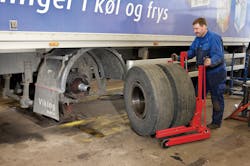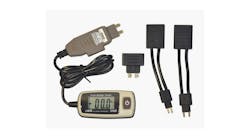In today’s demanding vehicle maintenance facilities in which speed, safety, and performance are key, the pace of change is driving fast. That is precisely why designing and equipping a modern fleet maintenance facility in which highly trained technicians are supported by the latest, safest equipment is imperative.
Nowhere is this more important than with heavy duty vehicle lifts – which have undergone dramatic technological advances over the past few decades. Consider the progression that not long ago, vehicle servicing was typically done by technicians gaining access to the undercarriage of vehicles by lying on creepers.
Most shops now recognize there are indeed better and safer ways to get the job done that are more effective in terms of performance, and safer from the perspective of ergonomics.
From a broader perspective, it is important to remember that in this environment, vehicle uptime is critical.
With this in mind, there are 10 essential steps to evaluate, select, and use heavy duty vehicle lifts to boost safety and performance in fleet maintenance shops:
- Certification counts: The Automotive Lift Institute (ALI) Lift Certification Program has made it easy for lift buyers to choose lifts that have been third-party tested and proven to meet safety and performance requirements outlined in the safety standard ANSI/ALI ALCTV (current edition). Testing includes verification of the structural integrity of all lift model systems and components, proper function of its controls and load-holding devices, the proper lowering speeds, and overload protection.
- Weight and height matters: Those who design and outfit vehicle maintenance facilities should know, in advance, the weight of the heaviest vehicle they intend to lift, and make certain that the lift selected is certified to meet or exceed that capacity. In terms of height, always measure the height clearance of the building and tallest vehicle before selecting a lifting system. In that way, shops can ensure ample room to raise a vehicle.
- Vigilance during setup: When ready to operate the lift, technicians should complete a full sweep of the area. Check the perimeter of the lift to confirm that nothing is obstructing its path and there are no hazards. Then, lift the vehicle no more than 12” off the ground, pause, and do another sweep of the area to further check that there are no impediments. Also, make sure that the vehicle being lifted is level.
- Authorized use: Make certain that only fully trained and authorized personnel operate the lift. Select a lifting system that prevents unauthorized access to lift operation. This could take the form of a locked control box or a secure key or “wand” required to activate the lift system before use.
- Keep it stable: Before operating a mobile column lift, always be sure each column is placed on a firm foundation and level ground. When lifting outdoors be aware of wind loads. Also, make certain that all personnel are clear of the vehicle and that the vehicle’s wheels are properly engaged with the forks on the lifts.
- Proper positioning: For inground lifts, operators should always check that the contact points are properly positioned. Further, select a lift with an “electronic synchronization” system. In this way, as the lift goes into motion, and continues through the full-range up to its maximum height, vehicles will lift smoothly, even those with unequal weight distribution, such as fire trucks, airport tugs, and pumper trucks.
- Technician protection: At all times, lift vehicles to the proper height. This allows technicians to move about freely and work comfortably underneath the vehicle. Some lifts, such as all Stertil-Koni lifts, feature an independent mechanical locking system that can be heard locking into place. The narrow locking intervals, at 1.375”, provide added safety and allow the lift to be lowered into the locks at a convenient height for the technician.
- Strict maintenance schedule: Make certain that all lifts are subject to a regular program of scheduled maintenance by following the manufacturer’s recommended schedule and receive an annual lift inspection by an ALI certified lift inspector.
- Use ergonomic tools and accessories: Stertil-Koni suggests using shop equipment and accessories specifically designed for particular lifts to ensure operator safety and proper ergonomics. Examples include:
- A high-lift wheel dolly allows wheel removal and proper alignment of dual tire assemblies and brake drums to be completed efficiently and accurately, without back strain.
- Consider using wireless mobile column lifts. These eliminate the need for interconnecting communication cables, and thus, remove the risk of tripping.
- Inground lift adapter kits facilitate more efficient lifting by cradling the front and rear axles of buses and trucks.
- Support stands are an essential secondary support device, engineered to securely support raised trucks, buses, and other vehicles, facilitating a broad range of maintenance procedures.
- Create a culture of safety: Beyond choosing the right lifting system, promoting a positive culture of safety is essential. Service bulletins, safety messages, and continuously updating technicians’ skills are vital to a smooth-running maintenance facility.
Safety and performance can work hand-in-hand to elevate vehicle maintenance facilities to new levels of efficiency, particularly when a well-conceived and implemented game plan is at the core of selecting and using heavy duty vehicle lifting systems.
Dr. Jean DellAmore, president of Stertil-Koni, has been in the heavy duty lift industry for more than 30 years. He has spent the last 22 years with Stertil-Koni and the first 12 years with SEFAC. DellAmore has several academic degrees including an MBA and MA from George Washington University, and a doctorate from UMUC. In his spare time he visits vehicle maintenance facilities, works as a volunteer Docent for the Library of Congress, and teaches a part time graduate course at UMUC in international business.


